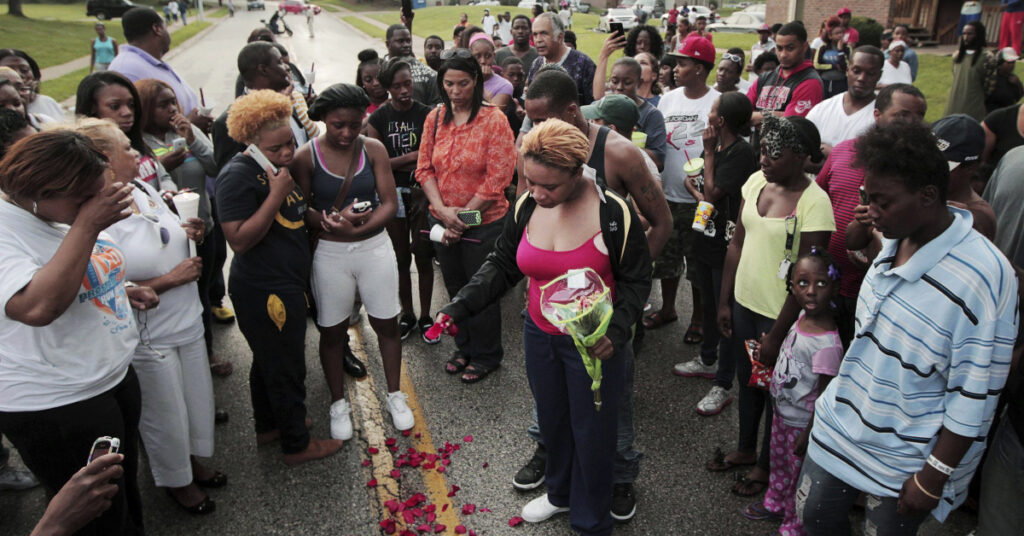FERGUSON, Mo. (AP) — On Aug. 9, 2014, Michael Brown and a friend were walking in the middle of Canfield Drive, a two-lane street in the St. Louis suburb of Ferguson, Missouri, when a police officer drove by and told them to use the sidewalk.
After words were exchanged, the white officer confronted the 18-year-old Brown, who was black. The situation escalated, with the officer and Brown scuffling. The officer shot and killed Brown, who was unarmed.
A timeline of key events that followed the shooting:
- AUG. 9, 2014: Brown’s bloodied body remains in the street for four hours in the summer heat. People in the neighborhood later lash out at police, saying they mistreated the body.
- AUG. 10, 2014: After a candlelight vigil, people protesting Brown’s death smash car windows and carry away armloads of food, alcohol and other looted items from stores. Some protesters stand on police cars, taunting officers. A QuikTrip convenience store on West Florissant Avenue, just blocks from where Brown was shot, is looted and burned. Other businesses are damaged or destroyed. It’s the first of several nights of unrest. The protests help solidify the Black Lives Matter movement formed in the wake of the 2012 death of black teenager Trayvon Martin in Florida and the acquittal of the neighborhood watch volunteer who shot him.
- AUG. 11, 2014: The FBI opens an investigation into Brown’s death, and two men who said they saw the shooting tell reporters that Brown had his hands raised when the officer fired repeatedly. That night, police in riot gear fire tear gas and rubber bullets to try to disperse a crowd of protesters.
- AUG. 14, 2014: The Missouri State Highway Patrol takes control of security, relieving Ferguson and St. Louis County officers of their law enforcement authority after days of unrest. The shift in command comes after images from the protests show many officers equipped with military-style gear, including armored vehicles, body armor and assault rifles. In photos circulated online, officers are seen pointing their weapons at demonstrators.
- AUG. 15, 2014: Police identify the officer who shot Brown as Darren Wilson, who had been with the department since 2011. They also release surveillance video that shows Brown grabbing large amounts of cigarillos from behind the counter of the Ferguson Market and pushing a worker who confronts him as he leaves the convenience store. Police say Brown took almost $50 worth of cigarillos. The release of the video upsets protesters.
- AUG. 16, 2014: Missouri Gov. Jay Nixon declares a state of emergency and imposes a curfew in Ferguson.
- AUG. 18, 2014: Nixon calls the National Guard to Ferguson to help restore order. He lifts the curfew.
- AUG. 20, 2014: U.S. Attorney General Eric Holder visits Ferguson to offer assurances about the investigation into Brown’s death and to meet with investigators and Brown’s family. A grand jury begins hearing evidence to determine whether Wilson should be charged.
- AUG. 21, 2014: Nixon orders the National Guard to withdraw from Ferguson.
- SEPT. 25, 2014: Ferguson Police Chief Tom Jackson releases a videotaped apology to Brown’s family and attempts to march in solidarity with protesters. The move backfires when Ferguson officers scuffle with demonstrators and arrest one person moments after Jackson, who is white, joins the group.
- NOV. 17, 2014: Nixon declares a state of emergency and activates the National Guard again ahead of a decision from a grand jury. He places Ferguson police in charge of security in Ferguson, with orders for them to work as a unified command with other departments.
- NOV. 18, 2014: Nixon names 16 people to the Ferguson Commission, an independent panel charged with examining race relations, failing schools and other social and economic issues. Nine of its members are black. Seven are white.
- NOV. 24, 2014: St. Louis County prosecutor Bob McCulloch announces that the grand jury has decided not to indict Wilson. Protests that were passionate but peaceful earlier in the day turn violent. At least a dozen buildings and multiple police cars are burned, officers are hit by rocks and batteries, and reports of gunfire force some St. Louis-bound flights to be diverted.
- NOV. 29, 2014: Wilson announces his resignation from the Ferguson Police Department effective immediately.
News Coverage from the AP

